Podcast
Questions and Answers
Which type of metabolism is carried out by chemolithotrophs?
Which type of metabolism is carried out by chemolithotrophs?
- Chemolithotrophy (correct)
- Autotrophy
- Chemoorganotrophy
- Phototrophy
Which of the following is a key characteristic of oxygenic photosynthesis?
Which of the following is a key characteristic of oxygenic photosynthesis?
- Carbon dioxide is not the carbon source
- Oxygen is consumed as a reactant
- Light is not used as an energy source
- Oxygen is produced as a byproduct (correct)
What is the key difference between heterotrophs and autotrophs in terms of carbon source?
What is the key difference between heterotrophs and autotrophs in terms of carbon source?
- Heterotrophs and autotrophs both use organic carbon
- Heterotrophs and autotrophs both use inorganic carbon
- Heterotrophs use organic carbon, autotrophs use inorganic carbon (correct)
- Heterotrophs use inorganic carbon, autotrophs use organic carbon
Which type of microorganisms are considered extremophiles?
Which type of microorganisms are considered extremophiles?
Which of the following is a key characteristic of anoxygenic photosynthesis?
Which of the following is a key characteristic of anoxygenic photosynthesis?
What is the relationship between chemoorganotrophs and heterotrophs?
What is the relationship between chemoorganotrophs and heterotrophs?
What was the key contribution of Sergei Winogradsky to the field of microbiology?
What was the key contribution of Sergei Winogradsky to the field of microbiology?
Which of the following is a key characteristic that distinguishes viruses from other microorganisms?
Which of the following is a key characteristic that distinguishes viruses from other microorganisms?
Which of the following microorganisms is considered a 'chemoorganotroph'?
Which of the following microorganisms is considered a 'chemoorganotroph'?
Which microorganism is an example of a 'phototrophic' organism, as described in the text?
Which microorganism is an example of a 'phototrophic' organism, as described in the text?
What is the relationship between chemolithotrophy and energy production in microorganisms, as described by Sergei Winogradsky?
What is the relationship between chemolithotrophy and energy production in microorganisms, as described by Sergei Winogradsky?
What is the connection between the discovery of viruses and the development of the field of virology, as described in the text?
What is the connection between the discovery of viruses and the development of the field of virology, as described in the text?
What is the term for organisms that obtain their energy from organic compounds?
What is the term for organisms that obtain their energy from organic compounds?
Which process describes the stable arrangement of mitochondria and chloroplasts in eukaryotic cells?
Which process describes the stable arrangement of mitochondria and chloroplasts in eukaryotic cells?
What is the main difference between chemoorganotrophs and chemolithotrophs?
What is the main difference between chemoorganotrophs and chemolithotrophs?
Which type of microorganism uses energy from inorganic compounds?
Which type of microorganism uses energy from inorganic compounds?
What are the three main ways in which organisms obtain energy in nature?
What are the three main ways in which organisms obtain energy in nature?
What is the process by which mitochondria and chloroplasts were incorporated into eukaryotic cells?
What is the process by which mitochondria and chloroplasts were incorporated into eukaryotic cells?
Flashcards are hidden until you start studying
Study Notes
Metabolic Pathways
- Chemolithotrophy is a type of metabolism where microorganisms use inorganic compounds as their energy source, found only in prokaryotes.
- Phototrophic microorganisms use light as an energy source and are colored due to pigments.
- There are two forms of phototrophy in prokaryotes: oxygenic photosynthesis (produces oxygen, unique to Cyanobacteria) and anoxygenic photosynthesis (does not produce oxygen, found in purple and green bacteria).
Types of Organisms
- Heterotrophs require one or more organic compounds as their carbon source, while autotrophs use CO2 as their carbon source.
- Chemoorganotrophs are a type of heterotroph that obtains energy from organic compounds.
- Extremophiles are organisms that thrive in extreme environments.
Microbial Environments
- Microorganisms are found in almost every environment that supports life.
- Extreme environments, which are common in microbial life, pose unique challenges to microorganisms.
Prokaryotic Diversity
- The domain Bacteria and Archaea are two distinct lineages of prokaryotic cells.
- Many Archaea are extremophiles, able to reproduce at high temperatures and extreme pH levels.
Historical Figures and Discoveries
- Beijerinck used the enrichment culture technique to obtain pure cultures of many microorganisms and discovered the first virus.
- Sergei Winogradsky proposed the term chemolithotrophy and described the theory of bacterial nitrogen fixation.
- Carl Woese identified ribosomal RNA as a tool for designing phylogenetic relationships.
Domains of Life
- There are three domains of life: Bacteria, Archaea, and Eukarya, which were formed from a common ancestral organism or communities of organisms.
- Eukarya cells contain mitochondria and chloroplasts, which were once free-living cells that established a stable settlement through endosymbiosis.
Energy Sources
- Energy is obtained in nature through organic chemicals, inorganic chemicals, and light.
- Chemoorganotrophs obtain energy from organic compounds, while some prokaryotes can use energy from inorganic compounds.
Studying That Suits You
Use AI to generate personalized quizzes and flashcards to suit your learning preferences.




